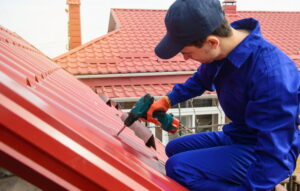Once you’ve installed your new HOA-approved roof, you likely expect it to protect you for many years to come without any maintenance. But despite its sturdy appearance, it requires regular servicing to make sure it stays in a great condition. Since not every roof is the same, you need to know which type of underlying structure it has and how to maintain it properly. Otherwise, its lifetime will come to an end much sooner than it should.
We’re here to help! In the following article, we’ll show you how to keep your roof in Orange County, CA, in a great condition and avoid costly HOA roof repair services. Read on to learn more.
What are the different types of HOA roofs and how do you maintain them?
Any roofing job with HOA can be daunting. Not only do you need to seek their approval to get your project off the ground, but you also need to understand some crucial HOA roofing guidelines. If all goes well, and you’ve finally installed your roof, you need to know how to maintain it.
The first step is to get familiar with some common roof types:
BUR
BURs (built-up roofs) have multiple layers of asphalt and fabric topped with heavy gravel. These roofs are highly durable and can endure the elements for quite a while. In general, they require little maintenance since the roof can’t be seen due to the gravel.
As the main purpose of gravel is to shield the roof from sunlight, the most pressing maintenance need is ensuring the material is fully covering the structure, and that there aren’t any bare spots. These can be caused by high winds that sweep gravel and pile it up in the roof’s corners. Roofers normally have to use adhesives and asphalt to reapply the gravel and ensure good coverage.
Besides making sure the gravel is protecting the membrane, owners of BUR roofs also need to prevent moisture from seeping through the membrane. To identify this issue, roof technicians use infrared gravimetric tools and test samples of the material.
Coal-tar pitch roof
Coal-tar pitch roofs are some of the oldest roofing systems. Instead of using asphalt, roofers install the membrane, cover it with tar pitch, and finish the project with gravel. As sunlight comes into contact with coal tar, the tar turns into liquid, runs back together, and fixes any holes on its own.
As with asphalt BURs, maintaining coal-tar pitch types requires moisture surveys. People need to ensure that moisture hasn’t reached the area underneath the material and harmed the structure atop of which it’s sitting.
 MBR
MBR
MBR (modified bitumen roofing) systems may be the most advanced type of BUR roofs. However, they don’t involve gravel on the top surface. Instead, the top membrane is held in place using modified bitumen. The sheet can be surfaced and smooth. The most distinct feature of this system are its gray granules.
This roofing system isn’t too demanding maintenance-wise. It doesn’t require frequent moisture surveys. All you need to do is conduct regular inspections to determine if there are any holes that need to be patched up. Again, hiring a professional roofer is the most efficient way to tackle this issue.
Looking for first-class Orange County, CA HOA roof repair services? The finest professionals are right here!
Knowing the type of your roof is the easy part of the maintenance process. The most important thing is to get up there and fix any damaged areas. To avoid working at dangerous heights and getting your hands dirty, reach out to 619 Roofing.
We are the leading roofing company in Orange County, CA and beyond with a proven track record of keeping people’s roofs in tip-top shape. While our experts are working their magic, why not check out the impressive science exhibits at the Discovery Cube? It’s a much more pleasing sight than dirty and noisy roof works. Contact us today!
 MBR
MBR